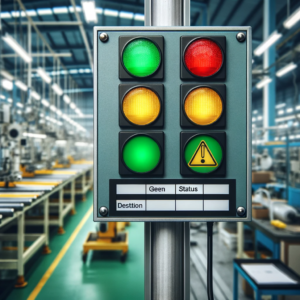We’ve compiled a list with an overview on Manufacturing-KPIs, the benefits of observing the right KPIs, and some examples for the journey on tracking your organization’s key performance indicators. The goal of every production company is the greatest possible efficiency. KPIs can be used to measure progress towards specific business goals. In the following, KPIs are presented, which should be measured to be successful in production.
Overall Equipment Efficiency
Starting with the Overall Equipment Efficiency (OEE), which monitors the productivity of a single machine. To illustrate this concretely, this KPI is divided into 3 factors:
Availability x Performance x Quality
It measures the proportion of time that a machine produces a good quality product during the planned time.
The following is an example to illustrate this point: A machine that normally runs for 8 hours produces 100 products per hour. On the measured day, the machine breaks down for 30 min. It furthermore produces 700 products, of which 640 are of good quality.
Calculation:
Availability: 7,5/8→93.75%, Performance: 700/750→93.33%, Quality: 640/700→91.42%
→93.75 x 93.33% x 91.42% → 80%
The following classification of the reasons for the losses helps to introduce improvement strategies.
Leadtime
Another KPI is the leadtime, the time it takes to complete an order from order confirmation to delivery. It gives an idea of how well a company processes orders and how quickly it can meet customer needs. Consequently, a short lead time is desirable. For greater transparency, this lead time can be fragmented. Here one distinguishes between the production time, delivery time to the customer and delivery time of the raw materials to the manufacturer.
One-Time-In-Full
The delivery time is accurately described by the supplier one-time-in full KPI. The quality of the suppliers and reliable partners are very important in production. One-time-in-full describes the number of smoothly delivered orders compared to the total number of orders. Here it is also important that the products were delivered in the desired quantity and quality. Therefore, the losses can be broken down into: Supply chain delay, product defect, delivery in wrong quantity.
Production Downtime
Another KPI, which refers to time, is the production downtime. When production processes come to a standstill, losses are incurred. These have different reasons, such as human error or broken machinery.
Stock Turnover Ratio
In order to make the best possible use of the available space, the KPI of the stock turnover ratio is used in production. Excess stock means that it has to be stored and is tied to a specific location. It is more efficient if space is used for production and not for storage. The higher than the inventory turnover ratio, the more effective the supply chain is. If overstocking is carried out, this ties up capital that could be invested in other areas.
Costs Per Unit (CPU)
Not only the storage of the products but also their price should be monitored. This is done via the KPI of the costs per unit (CPU). It helps to optimize production costs, offer competitive prices, and optimize profits. It is divided into: Material costs, labour costs and production costs. This determines how profitable a product is. The price is determined by adding the profit mark-up to the unit cost
Production Schedule Achievement (PSA)
Production planning should also be constantly optimized. For this purpose, one analyses the production schedule achievement (PSA). This also reflects how well staff have met their set targets. The more complex the production processes are, the more important is the ability to execute the plan precisely.
The production plan determines how much output is to be produced. Consequently, production plan fulfilment is defined by: actual output/ planned output. For example, this KPI can increase delivery accuracy by providing better estimates for the production of work orders






